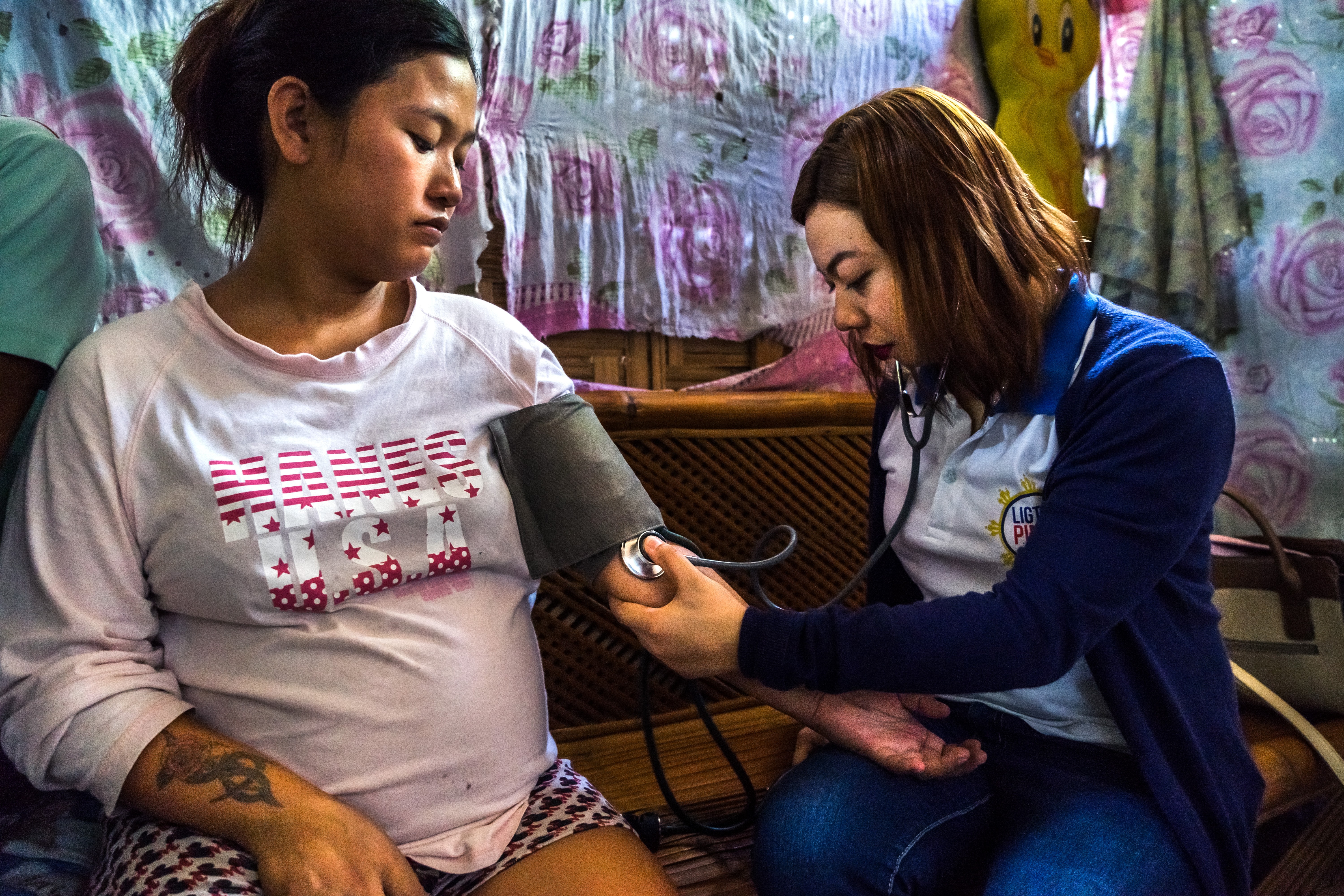Hypertension, often referred to as HTN or high blood pressure, is a common medical condition characterized by persistently elevated pressure in the blood vessels. Specifically, hypertension is diagnosed when blood pressure readings consistently measure at or above 140/90 mmHg. While it’s widespread, affecting a significant portion of the global population, hypertension can lead to severe health complications if left unmanaged. Many individuals with high blood pressure may not experience noticeable symptoms, making regular blood pressure checks crucial for early detection and prevention.
Understanding Blood Pressure Readings: Systolic and Diastolic
Blood pressure is recorded as two numbers, typically expressed as systolic pressure over diastolic pressure.
- Systolic Blood Pressure: This is the top number and represents the pressure in your arteries when your heart muscle contracts or beats, pumping blood out to the body.
- Diastolic Blood Pressure: This is the bottom number and indicates the pressure in your arteries when your heart muscle relaxes between beats, refilling with blood.
A diagnosis of hypertension is typically made when, on two separate occasions, measurements show a systolic blood pressure of ≥140 mmHg and/or a diastolic blood pressure of ≥90 mmHg. Understanding these readings is the first step in recognizing and managing hypertension.
What are the Risk Factors for Hypertension?
Several factors can increase an individual’s risk of developing hypertension. These risk factors are broadly categorized into modifiable and non-modifiable factors.
Modifiable Risk Factors
Modifiable risk factors are those that can be changed through lifestyle adjustments and interventions. These include:
- Unhealthy Diet: High intake of salt (sodium), saturated and trans fats, and low consumption of fruits and vegetables significantly contribute to high blood pressure.
- Physical Inactivity: A sedentary lifestyle increases the risk of hypertension. Regular physical activity is crucial for maintaining healthy blood pressure levels.
- Overweight or Obesity: Excess body weight puts additional strain on the cardiovascular system, elevating blood pressure.
- Tobacco Consumption: Smoking and tobacco use damage blood vessels and increase blood pressure.
- Excessive Alcohol Consumption: Heavy drinking can lead to a temporary and sometimes chronic increase in blood pressure.
- Environmental Factors: Exposure to air pollution has also been identified as a significant environmental risk factor for hypertension.
Non-Modifiable Risk Factors
Non-modifiable risk factors are those that cannot be changed. These include:
- Age: The risk of hypertension increases with age, particularly after 65 years old.
- Family History: A family history of hypertension increases an individual’s likelihood of developing the condition, suggesting a genetic component.
- Co-existing Diseases: Certain pre-existing health conditions such as diabetes and kidney disease can significantly elevate the risk of hypertension.
Recognizing the Symptoms of Hypertension
One of the challenges of hypertension is that most individuals experience no noticeable symptoms, especially in the early stages. This is why it is often called the “silent killer.” Regular blood pressure monitoring is vital for detection, as relying on symptoms can be misleading and dangerous.
Common Symptoms (Often Absent)
For many people with hypertension, there are no obvious warning signs. They may feel perfectly healthy, unaware that their blood pressure is elevated. This lack of symptoms underscores the importance of routine blood pressure checks.
Symptoms of Hypertensive Crisis
In cases of very high blood pressure, often termed a hypertensive crisis (typically 180/120 mmHg or higher), some individuals may experience noticeable and alarming symptoms, including:
- Severe Headaches
- Chest Pain
- Dizziness
- Difficulty Breathing
- Nausea and Vomiting
- Blurred Vision or Other Vision Changes
- Anxiety
- Confusion
- Buzzing in the Ears
- Nosebleeds
- Abnormal Heart Rhythm
If you experience any of these symptoms along with a high blood pressure reading, it is critical to seek immediate medical attention. A hypertensive crisis is a medical emergency that requires prompt treatment.
How is Hypertension Treated?
Managing hypertension typically involves a combination of lifestyle modifications and, in many cases, medication. The goal of treatment is to lower blood pressure to a healthy range and prevent complications.
Lifestyle Modifications
Lifestyle changes are often the first line of defense and a crucial component of long-term hypertension management. These include:
- Healthy, Low-Salt Diet: Adopting a diet rich in fruits, vegetables, and low in sodium, saturated, and trans fats (like the DASH diet) can significantly lower blood pressure. Aiming for less than 2 grams of salt per day is often recommended.
- Weight Management: Losing weight if overweight or obese can have a substantial positive impact on blood pressure.
- Regular Physical Activity: Engaging in regular aerobic exercise, such as brisk walking, running, swimming, or cycling, for at least 150 minutes of moderate-intensity activity per week, along with strength training exercises twice a week, is highly beneficial.
- Smoking Cessation: Quitting smoking or tobacco use is essential for overall cardiovascular health and blood pressure management.
- Moderate Alcohol Consumption: If you drink alcohol, do so in moderation. This means up to one drink per day for women and up to two drinks per day for men.
Medications for Hypertension
If lifestyle changes alone are not sufficient to control blood pressure, or for individuals with more severe hypertension or other health conditions, medication may be necessary. Several classes of medications are commonly used to treat hypertension:
- ACE Inhibitors (e.g., enalapril, lisinopril): These medications help relax blood vessels and can also protect the kidneys.
- Angiotensin II Receptor Blockers (ARBs) (e.g., losartan, telmisartan): ARBs work similarly to ACE inhibitors, relaxing blood vessels and protecting kidneys.
- Calcium Channel Blockers (e.g., amlodipine, felodipine): These drugs relax blood vessels by preventing calcium from entering muscle cells of the heart and blood vessel walls.
- Diuretics (e.g., hydrochlorothiazide, chlorthalidone): Diuretics, often called “water pills,” help the body eliminate excess water and sodium, which lowers blood pressure.
The specific medication or combination of medications prescribed will depend on individual health needs and other co-existing conditions. Common blood pressure goals are generally less than 140/90 mmHg for most people, and even lower (less than 130/80 mmHg) for those with cardiovascular disease, diabetes, chronic kidney disease, or high risk for cardiovascular disease.
Preventing Hypertension: Proactive Steps for Health
Preventing hypertension is possible and crucial for maintaining long-term health. Many of the lifestyle modifications used to treat hypertension are also effective in preventing it. Proactive steps include:
- Embrace a Healthy Diet: Focus on a diet rich in fruits, vegetables, and low in processed foods, saturated and trans fats, and sodium.
- Increase Physical Activity: Make regular physical activity a part of your daily routine.
- Maintain a Healthy Weight: Achieve and maintain a healthy weight through diet and exercise.
- Limit Sodium Intake: Reduce consumption of salty foods and processed foods high in sodium.
- Moderate Alcohol Consumption: If you drink alcohol, do so in moderation.
- Avoid Tobacco Products: Do not smoke or use tobacco products.
- Manage Stress: Practice stress-reducing techniques such as yoga, meditation, or deep breathing exercises.
- Regular Blood Pressure Checks: Get your blood pressure checked regularly by a healthcare professional, even if you feel healthy.
- Manage Other Medical Conditions: Effectively manage conditions like diabetes and kidney disease, which can increase hypertension risk.
- Reduce Exposure to Air Pollution: Minimize exposure to polluted air where possible.
Complications of Untreated Hypertension
Uncontrolled hypertension can lead to serious and potentially life-threatening health complications. The persistently high pressure damages blood vessels and organs over time, increasing the risk of:
- Heart Disease: Hypertension is a major risk factor for various heart conditions, including:
- Angina (Chest Pain): Reduced blood flow to the heart muscle can cause chest pain.
- Heart Attack: Blockage of blood supply to the heart muscle, leading to damage or death of heart tissue.
- Heart Failure: The heart becomes unable to pump enough blood to meet the body’s needs.
- Irregular Heartbeat (Arrhythmia): Which can sometimes lead to sudden cardiac death.
- Stroke: Hypertension can cause blood vessels in the brain to burst or become blocked, leading to stroke and brain damage.
- Kidney Disease and Kidney Failure: Damage to blood vessels in the kidneys can impair kidney function, potentially leading to kidney failure.
- Vision Problems: High blood pressure can damage blood vessels in the eyes, leading to vision loss.
- Peripheral Artery Disease (PAD): Narrowing of arteries in the limbs, often the legs, due to hypertension-related damage.
Hypertension: A Global Health Concern
Hypertension is a global health challenge, with prevalence varying across regions and income levels. The World Health Organization (WHO) highlights that the WHO African Region has the highest prevalence, while the Region of the Americas has the lowest. Globally, the number of adults with hypertension has increased significantly over recent decades, with a disproportionate rise in low- and middle-income countries. This increase is largely attributed to a rise in hypertension risk factors within these populations.
The WHO actively works to support countries in reducing hypertension as a public health problem through initiatives like the Global Hearts Initiative and the HEARTS technical package. These programs aim to strengthen the prevention and control of cardiovascular disease worldwide, providing evidence-based guidelines and support for implementing effective hypertension management programs in various healthcare settings.
In Conclusion
Hypertension, or high blood pressure, is a serious condition that often presents without noticeable symptoms. Understanding what HTN is, its risk factors, and the importance of regular blood pressure monitoring are crucial steps in prevention and management. Lifestyle changes are fundamental in both preventing and treating hypertension, and medication is often a necessary component of care. By taking proactive steps to manage blood pressure, individuals can significantly reduce their risk of developing severe health complications and improve their overall quality of life. Remember to consult with healthcare professionals for personalized advice and management strategies for hypertension.

